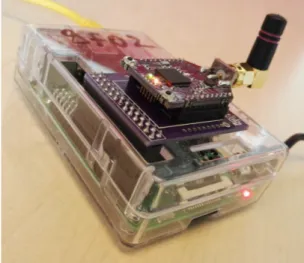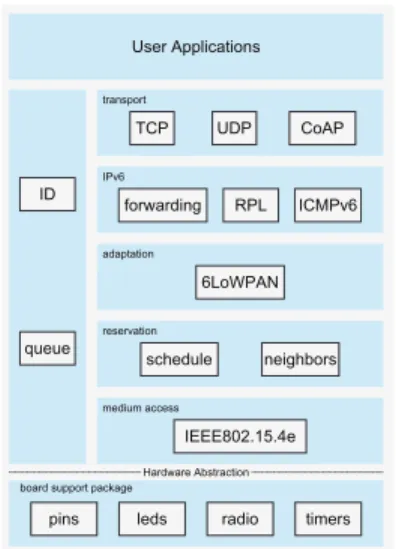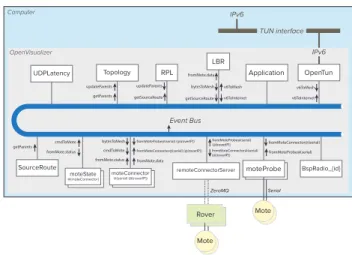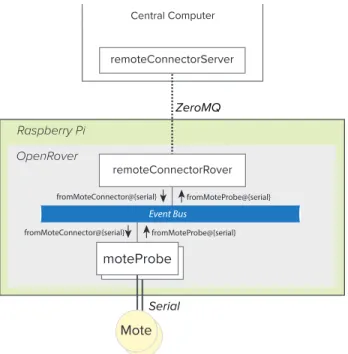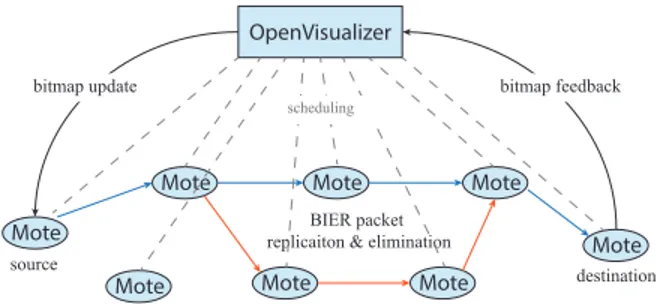HAL Id: hal-01359812
https://hal.inria.fr/hal-01359812
Submitted on 20 Dec 2016
HAL is a multi-disciplinary open access
archive for the deposit and dissemination of
sci-entific research documents, whether they are
pub-lished or not. The documents may come from
teaching and research institutions in France or
abroad, or from public or private research centers.
L’archive ouverte pluridisciplinaire HAL, est
destinée au dépôt et à la diffusion de documents
scientifiques de niveau recherche, publiés ou non,
émanant des établissements d’enseignement et de
recherche français ou étrangers, des laboratoires
publics ou privés.
Rover: Poor (but Elegant) Man’s Testbed
Zacharie Brodard, Hao Jiang, Tengfei Chang, Thomas Watteyne, Xavier
Vilajosana, Pascal Thubert, Géraldine Texier
To cite this version:
Zacharie Brodard, Hao Jiang, Tengfei Chang, Thomas Watteyne, Xavier Vilajosana, et al.. Rover:
Poor (but Elegant) Man’s Testbed. ACM International Symposium on Performance Evaluation of
Wireless Ad Hoc, Sensor, and Ubiquitous Networks (PE-WASUN), Nov 2016, Valletta, Malta.
�hal-01359812�
Rover: Poor (but Elegant) Man’s Testbed
Zacharie Brodard
Cisco Systems Paris, Francebrodazac@cisco.com
Hao Jiang
Cisco Systems Paris, Francehjiang2@cisco.com
Tengfei Chang
Inria, EVA team Paris, France
tengfei.chang@inria.fr
Thomas Watteyne
Inria, EVA team Paris, France
thomas.watteyne@inria.fr
Xavier Vilajosana
Univ. Oberta de Catalunya Barcelona, Catalunya, Spain
xvilajosana@uoc.edu
Pascal Thubert
Cisco Systems, France Telecom Bretagne, France
pthubert@cisco.com
ABSTRACT
This paper presents the OpenVisualizer Rover testbed, a simple, easy-to-deploy and cheap testbed for the Internet of Things (IoT). The OpenWSN project provides a free and open-source implementation of a standards-compliant pro-tocol stack for the IoT, as well as all the necessary network management and debugging tools. The network manage-ment software, OpenVisualizer, is portable across popular operating systems, and connects the OpenWSN low-power wireless mesh network to the Internet. In the current setup, motes are connected to the USB ports of the computer the OpenVisualizer runs on. The OpenVisualizer monitors the internal state of those motes, which it presents through a
web interface. Rover extends the OpenVisualizer by
al-lowing motes plugged into different computers to remotely connect to it. Once connected, a user monitors and man-ages the motes exactly as if they were connected locally. This offers endless experimentation possibilities, as the re-sulting testbed can be quickly (re)deployed in realistic envi-ronments. An example Rover testbed has been deployed at the Cisco Paris Innovation and Research Lab. This paper discusses the Rover architecture, the deployment, and the experimental research done with it.
CCS Concepts
•Networks → Network experimentation; Network pro-tocol design; Network measurement;
Keywords
Internet of Things; Testbed; OpenWSN; OpenMote.
1.
INTRODUCTION
With the development of new technologies in ICT, we are witnessing during the last few years the emergence and fast growth of the Internet of Things (IoT). To exploit, test and
Permission to make digital or hard copies of all or part of this work for personal or classroom use is granted without fee provided that copies are not made or distributed for profit or commercial advantage and that copies bear this notice and the full cita-tion on the first page. Copyrights for components of this work owned by others than ACM must be honored. Abstracting with credit is permitted. To copy otherwise, or re-publish, to post on servers or to redistribute to lists, requires prior specific permission and/or a fee. Request permissions from permissions@acm.org.
PE-WASUN’16 13–17 November 2016, Valletta, Malta
c
2016 ACM. ISBN XXX-XXXX-XX-XX/XX/XX. . . $15.00
DOI:XX.XXX/XXX X
Figure 1: A Rover node.
verify new IoT technologies and standards, several experi-mental testbeds have been developed and deployed to enable experimental research and benchmarking. FIT IoT-lab [1] is a testbed deployed in 6 sites across France, composed of 2728 low-power wireless nodes and 117 mobile robots, avail-able for experimenting with large-scale wireless IoT tech-nologies. Indriya [2] is another large-scale wireless sensor network testbed deployed at the National University of Sin-gapore. It uses TelosB devices and is built on an active-USB
infrastructure. Tutornet1is a testbed running in Ronald
Tu-tor Hall at University of Southern California. It consists of 13 clusters, each cluster composed of a stargate and several motes attached via USB cables. A central PC can program any mote in the testbed through the communication with these stargates over WiFi.
Such shared testbeds have a couple of shortcomings. First, they are shared by nature: one has to wait for the motes to become available before being able to start an experiment. Second, they only feature a handful of types of motes (hard-ware) and its hard – if at all possible – to swap the hardware used. Third, they are deployed in a single location, which is not representative of the variety of environments low-power networks are deployed in. Forth, these testbeds are com-plex and expensive to install, and often require a team of 1
Figure 2: The OpenWSN protocol stack.
full-time engineers or grad students to keep them up and running. And finally, these testbeds are academic/open by nature, and not appropriate for in-house developments or proprietary technology. The goal of the Rover architecture presented in this paper is to address these shortcomings.
Rover combines the strengths of the OpenMote hardware
and the OpenWSN software. OpenMote2 [6] is an
open-hardware prototyping ecosystem designed to accelerate the development of the Industrial Internet of Things (IIoT). The
OpenMote-CC2538 is the core of this ecosystem. It is a
4 cm × 3 cm board which provides computation and com-munication capabilities. Its main component is the Texas Instrument CC2538, a System-on-Chip (SoC) with a 32-bit ARM Cortex-M3 micro-controller and a 2.4GHz IEEE802.15.4
radio transceiver. OpenWSN3[7] provides an open-source
implementation of a fully standards-based protocol stack for the IoT, running on a variety of hardware and software platforms. With a suite of free and open-source debugging and integration tools, it aims to help academia and indus-try verify the applicability of these standards to the Inter-net of Things. It is the reference open-source implementa-tion of the IEEE802.15.4-2015 Time Synchronized Channel Hopping (TSCH) standard and IPv6 over TSCH (6TiSCH). Fig. 2 depicts the protocol stack implemented in OpenWSN. OpenMote and OpenWSN have been designed together.
The Raspberry Pi4is a credit-card sized single-board
com-puter, which aims at providing low-cost, high-performance computers to stimulate the education of basic computer sci-ence at schools. It features a Broadcom BCM2835 SoC, and uses an SD card for booting and long-term storage. The dif-ferent Debian and Arch Linux flavors that run on it comes with a Python interpreter. It has become very popular gate-way computer for IoT networks. Rover uses it as the default platform to connect OpenMote boards to.
The goal of Rover is to offer all the pieces necessary for building a testbed which is easily (re-)deployable, cheap and
running cutting-edge IOT protocols and standards. The
Rover testbed integrates the Raspberry Pi, OpenMote and 2 www.openmote.com 3 www.openwsn.org 4 www.raspberrypi.org OpenWSN projects.
The contribution of this paper is threefold:
• It presents Rover, an easy-to-deploy, cheap, standards-ready testbed for the IoT.
• It shows an example deployment of a Rover testbed at Cisco-Paris.
• It discusses cases for which this type of testbed in par-ticularly suited.
The remainder of this paper is organized as follows. Sec-tion 2 introduces the OpenVisualizer, the software running on the PC controller the testbed. Section 3 presents the Rover architecture, highlights the components developed as an contribution to the OpenVisualizer, and lists the key fea-tures of the Rover testbed. Section 4 describes how a Rover tesbed is currently deployed at Cisco-Paris. Section 5 dis-cusses example use cases in which Rover-based experimen-tation is particularly suitable. Finally, Section 6 concludes this paper and discusses future work.
2.
OPENVISUALIZER
The OpenVisualizer is a Python-based debugging and vi-sualization tool that runs on a Windows/Linux/OSX com-puter and interacts with the motes connected to it over se-rial ports. It includes 6LoWPAN Low-power Border Router (LBR) functionality, i.e. it translates 6LoWPAN packets into IPv6 packets, thereby connecting the low-power wireless mesh to the Internet. Its web-based user interface provides relevant information about the OpenWSN network. This includes the internal states of each mote (neighbor table, communication schedule, routing table, a.o.), the multi-hop routing structure, and the debug/error messages generated by the motes. The OpenVisualizer also sends commands and data to the motes, in particular packets coming from the Internet.
The OpenVisualizer is built following the “Event Bus” software design pattern. Components connected to the Event Bus use a publish-subscribe approach to send messages to one another. This modular software architecture makes the code maintainable, flexible and extensible. The Event Bus has proven to be a powerful tool to write applications and support the ongoing development of communication stan-dards and protocols.
Fig. 3 depicts the general architecture of the OpenVisu-alizer. The Event Bus provides the messaging framework for the full chain of services between a mote and the exter-nal network. Components are conceptually grouped into the functional areas shown on the bus. Each component imple-ments an event handler and provides a specific service. The openTun component creates and uses an IPv6 virtual TUN in-terface, allowing motes to communicate with external appli-cations running on the Internet. LBR is the component that provides low-power border router translation between IPv6 packets on the external network, and 6LoWPAN packets in the low-power wireless mesh. The RPL component manages the multi-hop routes by implementing the RPL standard. It receives the RPL DAO messages sent by the motes, and maintains a central view of the RPL topology; it uses that view to build source routes for packet sent into the mesh. Each moteConnector is the primary interface for an individ-ual mote; it pushes events out from the mote onto the bus, for other components to display/interpret.
OpenVisualizer Event Bus IPv6 TUN interface Application LBR RPL moteState UDPLatency Topology BspRadio_{id} Computer moteProbe Mote moteProbe Serial Mote OpenTun IPv6 moteConnector @{serial} SourceRoute moteState @{moteConnector} v6ToInternet v6ToMesh v6ToMesh v6ToInternet getSourceRoute bytesToMesh updateParents getSourceRoute updateParents getParents getParents cmdToMote fromMote.status bytesToMesh cmdToMote fromMote.status fromMote.data fromMote.data fromMoteConnector@{serial} fromMoteProbe@{serial} fromMoteConnector@{serial} fromMoteProbe@{serial}
Figure 3: OpenVisualizer without Rover.
Each moteConnector communicates with a mote over a serial port using a moteProbe component. For each message received from the mote, the moteProbe encapsulates it as an event which it publishes on the Event Bus. Similarly, the moteProbe subscribes to fromMoteConnector@{serial} notifications at the Event Bus, to forward them to the mote
over its serial port. The serial frames between the mote
and the computer are framed using HDLC, implementing RFC1662 [4]. The payload of the HDLC frame has a leading 1-byte “type” field which indicates the format of the followed payload.
With each mote connected to the OpenVisualizer through the serial, and almost all the necessary information about the low-power wireless mesh fully visualized, it becomes easy to conduct IoT research and development activities. Yet, it requires for all the nodes to be physically connected to a same computer, severely limiting the scalability of the ap-proach.
3.
THE ROVER TESTBED
In any realistic deployment, the different motes of the mesh are not close enough to be connected directly to the same computer running the OpenVisualizer. What is needed is a mechanism to allow some motes to connect remotely. This paper presents the improvement to the OpenVisualizer which allows just that. We implemented the “Rover” mod-ule, a version of the moteProbe which is connected to the serial port of the mote, and connects to the main Event Bus of the OpenVisualizer remotely.
3.1
Architecture
The new architecture can be divided into two parts, with most components running in the central OpenVisualizer, and the moteProbe components running remotely on each Rover node. The architecture defines a new remoteConnec-torServer component for the OpenVisualizer, and a re-moteConnectorRover component for the Rover node. These bridge the signaling data between the motes and the cen-tral computer, without removing any of the OpenVisualizer functionality. Fig. 4 shows the resulting OpenVisualizer ar-chitecture.
The original moteProbe component still remains available; the new architecture supports both local and remote motes, concurrently. RemoteConnnectorServer is the new
Open-OpenVisualizer Event Bus IPv6 TUN interface Application LBR RPL UDPLatency Topology BspRadio_{id} Computer OpenTun IPv6 v6ToInternet v6ToMesh v6ToMesh v6ToInternet getSourceRoute bytesToMesh updateParents getSourceRoute updateParents getParents SourceRoute getParents moteState @{moteConnector} cmdToMote fromMote.status fromMote.data moteConnector @{serial} (@{roverIP}) bytesToMesh cmdToMote fromMote.status fromMote.data fromMoteConnector@{serial} (@{roverIP}) fromMoteProbe@{serial} (@{roverIP}) fromMoteConnector@{serial} (@{roverIP}) moteProbe Mote moteProbe Serial Mote fromMoteConnector@{serial} fromMoteProbe@{serial} ZeroMQ remoteConnectorServer Mote Mote Rover fromMoteProbe@{serial} (@{roverIP})
Figure 4: OpenVisualizer with Rover.
Visualizer component which allows the mote to connect
re-motely. It maintains a TCP session between each Rover
node and the main OpenVisualizer. Through that session, it transfers all the events destined to a remote Rover node. Simlarly, it receives incoming events from the Rover nodes,
and dispatches them in the local Event Bus. No other
changes to the core components of the OpenVisualizer were necessary.
The remoteConnectorServer communicates with each
re-moteConnectorRover using ZeroMQ5. ZeroMQ is an
asyn-chronous messaging system which offers one-to-many com-munication between the OpenVisualizer and the Rover nodes. Components exchange messages using a publish-subscribe pattern: the remoteConnectorServer publishes events the Rover nodes subscribe to, and subscribes to all the Rover nodes to receive their events. The result is that the Event Bus of OpenVisualizer is extended remotely to each Rover node; all events are transparently transferred between com-ponents, whether local or remote.
3.2
Additional Features
The Rover functionality is built into the OpenPi
plat-form6, the OpenWSN-ready distribution for the Raspberry
Pi. In the OpenPi, an OpenVisualizer Rover program runs as a service called “openrover”, and serves socket connection requests from the central OpenVisualizer.
Once the remote connection is established, the OpenVisu-alizer is able to monitor and manage all the motes, regardless of whether they are local or remote. It also allows the user to remotely reset or reflash the motes with any arbitrary firmware.
The Rover code was contributed to the OpenWSN project,
and is available under an open-source BSD license7.
4.
EXAMPLE DEPLOYMENT
Fig. 1 shows a Rover node, consisting of an OpenMote
and a Raspberry Pi. Fig. 5 show the block diagram of
5
http://zeromq.org/
6 openpi.openwsn.org
7
As an online addition to this paper, all source code is avail-able at https://github.com/openwsn-berkeley/openpi under a BSD open-source license.
Raspberry Pi OpenRover ZeroMQ remoteConnectorRover Event Bus Central Computer moteProbe Mote moteProbe Serial Mote fromMoteProbe@{serial} fromMoteProbe@{serial} fromMoteConnector@{serial} fromMoteConnector@{serial} Event Bus remoteConnectorServer
Figure 5: Functional block diagram of a Rover node.
OpenMote-CC2538 75e Raspberry Pi 3 35e enclosure 5e SD card 15e RJ45 cable 5e Total 135e
Table 1: Approximate cost of a Rover node.
the software running on the Raspberry Pi The moteProbe component is equivalent to that running in the OpenVisu-alizer. It is the remoteConnectorRover component which maintains the (remote) connection to the OpenVisualizer The remoteConnectorRover component subscribes to the fromMoteProbe@{serial} events from the local Event Bus, and forwards them to the OpenVisualizer. Similarly, the remoteConnectorRover component republishes fromMote-Connector@{serial}@{roverIP} events received from the OpenVisualizer into local Event Bus.
The remoteConnectorRover communicates with the re-moteConnectorServer on the OpenVisualizer using ZeroMQ. Each time a Rover node connects, the OpenVisualizer cre-ates dedicated moteState and moteConnector components, identified by the “@{roverIP}” and “@{serial}” suffixes. From that moment on, Rover node and the OpenVisualizer exchange all relevant information.
Table 1 gives an approximate cost of a Rover node. A Rover-based testbed is currently deployed on the sixth floor of the Cisco Innovation and Research Lab in Paris, France. Fig. 6 shows the 8-node topology, each label are the last 2 bytes of the OpenMote’s MAC address, in hexadecimal
notation. Mote 9E-D9 is the DAGroot, and is connected
to the Raspberry Pi which serves as the central computer running the OpenVisualizer. The remaining nodes remote, each connected to a Raspberry Pi running the OpenRover software. For this experiment, The topology is hardcoded
Blackout Blinds Projection screen Project ion screen Existing Air con MDF board screen Existing 2no. racks Write able wall MX30 0
White Board Wall J1-3 640 F5-7A J1-6 Q1-2 M1-11A F3-10 J1-4 C4-11 R1-2 M5-13 629 G3-6 J1-1 T1-2 G4-11 R1-11 Q1-11 F5-7 G4-7 A1-14 614 F1-5 G4-6 652 G3-1A M4-4 F4-3 666 M1-11 F1-8 618 679 M5-15 A1-11 G4-8 M4-3 F1-9 M1-2 O5-5A F4-11 Q1-1 653 671 670 E5-11 S1-2 615 616 604 605 606 607 613 610 641 642 643 644 645 617 636 668 F1-6 F1-2 F1-1 E1-6 E1-2 E1-1 C5-2 C5-6C5-7 E5-1 G2-2 O5-10 P5-1 P5-6 T1-7 T1-1 S1-7 S1-1 R1-7 R1-1 Q1-9 Q1-3 Q1-4 M1-7 M1-1 667 683 G4-3 Q1-7 635 S1-11 M1-8 A1-10 M1-12 601 E1-5 D1-7A M5-8 G3-7 673 A1-1A Q1-6 J1-5 T1-11 682 623A F2-5 638 F3-11 608 609 611 612 C5-1 B5-5 B5-4 B5-1 A5-5 E5-6 F5-1 F5-6 F5-2 G4-1G4-2 G3-2 F3-5G3-1 G2-1 A1-1 A1-6 A1-2 A1-7 D1-11 D1-6 D1-12 D1-7 D1-1 D1-2 E1-7 F1-7 I1-11 I1-12 I1-7 I1-6 I1-1 I1-2 L1-12 L1-7 L1-2 L1-11 L1-6 L1-1 M1-6 P1-12 P1-7 P1-2 P1-11 P1-6 P1-1 Q1-8 R1-6 S1-6 T1-6 P5-10 Q5-6 O5-5 619 621 620 622 637 639 J1-2 APR 622 INNOVATION CENTER APR 624
Gov. Affairs Office EIFFEL APR 6-1 SH-14 SH-13 ELEV4 ELEV3 SH-20 SH-2 STAIR1 SH-1 SH-3 SH-4 SH-5 SH-6 600 600A 656 654 655 627 626 628 625 624 669 665 C-3 C-2 C-13 623 SH-17 SH-18 SH-9 SH-7 STAIR2 SH-8 ELEV2 ELEV1 STAIR3 SH-16 SH-11 SH-10 SH-19 SH-12 STAIR4 SH-15 FD 9E-C3 9E-F6 9E-EC 9E-D8 9E-C7 9F-02 9F-4A 9E-D9 (DAGroot)
Figure 6: Bird view of the Rover testbed running at Cisco-Paris.
in a general shape of a ladder, and each mote check at layer 2 if each received packet comes from one of their neighbors, if not the packet is simply dropped.
5.
EXAMPLE USE CASE
This section illustrates how the Rover testbed is used to conduct research on 6TiSCH [5] schedule management with Traffic Engineering for Bit Indexed Explicit Repliation (BIER-TE).
BIER (Bit Indexed Explicit Replication) is a new multi-cast forwarding protocol [8]. When a multimulti-cast data packet enters a BIER domain, the ingress router determines a set of egress routers to which the packet needs to be sent, and then encapsulates the packet in a BIER header. The BIER header contains a bitstring in which each bit represents ex-actly one egress router in the domain. To send a packet to a particular set of egress nodes, the ingress node sets the bits for each of those egress nodes, and clears other bits in the bitstring. Each packet can then be forwarded along the uni-cast shortest path tree from the ingress node to the egress nodes based on some routing protocol.
BIER-TE [3] is a Traffic Engineering technique inspired from BIER and being standardized. It forwards and repli-cates packets based on BIER-like bitstrings, but does not require an routing protocol. The key differences over BIER are: (1) BIER-TE replaces in-network, autonomous, and IGP-based path calculation by explicit paths calculated of-f-path by a controller; (2) in BIER-TE, every bitposition of the bitstring of a BIER-TE packet indicates one or more ad-jacencies – instead of a set of destination nodes as in BIER; (3) in BIER-TE, each node has no routing table but only a BIER-TE Forwarding Table (BIFT). The BIFT specifies how the node should replicate packets to its adjacencies ac-cording to the bitstring contained in the BIER header of the packet. BIER-TE can thus be used to enable path di-versity by controlling replication and elimination by tuning the bitstring in the BIER header. The output bitstring from the last node in path can be used to identify transmission failures, and this information can be passed to the central controller, which in turn can modify the bitString for the next packets.
To explore the performance of BIER-TE on a 6TiSCH low-power wireless mesh, we implemented BIER-TE on Open-WSN and evaluated its performance on the Cisco-Paris Rover testbed. Fig. 7 depicts how the test is used. The Open-Visualizer shows the network topology in real time. Upon receiving a new flow, the OpenVisualizer computes a
com-OpenVisualizer Mote Mote Mote Mote Mote Mote Mote Mote
bitmap update bitmap feedback
BIER packet replicaiton & elimination
source destination
scheduling
Figure 7: Using the Rover testbed to benchmark BIER-TE on OpenWSN.
plex path, reserves timeslots, and installs a BIFT into each node over their serial port. An associated bitmap for this flow is then assigned by the OpenVisualizer in the ingress node, and inserted into the BIER header of each packet. Each node along the path receiving the packet examines the bitmap against its BIFT and performs packet forwarding, replication or elimination operations. When the destination node receives the packet, it forwards the payload data to the upper layer and feeds the bitmap and delay back to Open-Visualizer. With the Rover testbed, various experiments are conducted to benchmark the performance of BIER-TE over 6TiSCH. For each experiment, the code is instrumented to measure jitter, latency, loss ratio and reliability.
The Rover testbed thus proved itself essential to conduct this real-world experimental study. It integrates both the advanced OpenWSN software and the state-of-the-art Open-Mote hardware. It includes an open-source and up-to-date implementation of a complete protocol stack based on IoT standards, which makes the testbed complete and powerful. The real-time network visualization makes it simple and easy to use. The OpenVisualizer offers network monitoring and management capabilities, no matter whether the mote is lo-cal or remote, real or simulated. The fact that each Rover node can be positioned anywhere while maintaining the con-nection with the central OpenVisualizer is a critical feature. Because of their Ethernet connectivity, and the low cost of the nodes, the testbed can be redeployed in minutes. We strongly believe the Rover architecture is key tool for con-ducting benchmarking and feasibility studies, in particular for the standards for the Industrial IoT.
6.
CONCLUSION
This paper introduces Rover, an IoT testbed which com-bines OpenWSN software and OpenMote hardware in an easy-to-use, flexible and cheap solution. It offers an ideal real-world experimentation environment for both academic and industry R&D activities, and will help shape the future of the Internet of Things. It improves to the OpenVisualizer software by allowing node to connect remotely. Through the connection, the OpenVisualizer and Rover node exchange signaling and data.
We are currently working on a mechanism for the Open-Visualizer to automatically discover the Rover nodes which are in the local network, either through mDNS, or by using a registration mechanism to a resource directory. We are also working towards a Rover node which uses an Intel Edison rather than a Raspberry Pi. This will allow Rover nodes to connect to WiFi (at 5 GHz) rather than Ethernet, offering even more flexibility.
Acknowledgment
This work was partly supported by the European Commis-sion’s Horizon 2020 Framework Programme, through the H2020 F-Interop and H2020 ARMOUR projects.
7.
ADDITIONAL AUTHORS
Additional author: Geraldine Texier (Telecom Bretagne, email: geraldine.texier@telecom-bretagne.eu).
8.
REFERENCES
[1] C. Adjih, E. Baccelli, E. Fleury, G. Harter, N. Mitton, T. Noel, R. Pissard-Gibollet, F. Saint-Marcel,
G. Schreiner, J. Vandaele, and T. Watteyne. FIT IoT-LAB: A large scale open experimental IoT testbed. In World Forum on Internet of Things (WF-IoT), pages 459–464, Milan, Italy, 14-16 December 2015. IEEE.
[2] M. Doddavenkatappa, M. C. Chan, and A. L. Ananda. Indriya: A Low-cost, 3D Wireless Sensor Network Testbed. In International ICST Conference on Testbeds and Research Infrastructures for the Development of Networks and Communities (TridentCom), pages 302–316, Shanghai, China, 17-19 April 2011. Springer. [3] T. Eckert, G. Cauchie, W. Braun, and M. Menth.
Traffic Engineering for Bit Index Explicit Replication BIER-TE, 8 July 2016.
[4] W. A. Simpson. PPP in HDLC-like Framing. RFC1662, July 1994.
[5] P. Thubert. An Architecture for IPv6 over the TSCH mode of IEEE 802.15.4. draft-ietf-6tisch-architecture-10 [work-in-progress], 10 June 2016.
[6] X. Vilajosana, P. Tuset, T. Watteyne, and K. Pister. OpenMote: Open-Source Prototyping Platform for the Industrial IoT. In 7th EAI International Conference on Ad Hoc Networks (AdHocNets), pages 211–222, San Remo, Italy, 1-2 September 2015. Springer.
[7] T. Watteyne, X. Vilajosana, B. Kerkez, F. Chraim, K. Weekly, Q. Wang, S. Glaser, and K. Pister. OpenWSN: a Standards-based Low-Power Wireless Development Environment. Transactions on Emerging Telecommunications Technologies (ETT),
23(5):480–493, 2012.
[8] I. Wijnands, E. C. Rosen, A. Dolganow, T. Przygienda, and S. K. Aldrin. Multicast using Bit Index Explicit Replication. draft-ietf-bier-architecture-04
